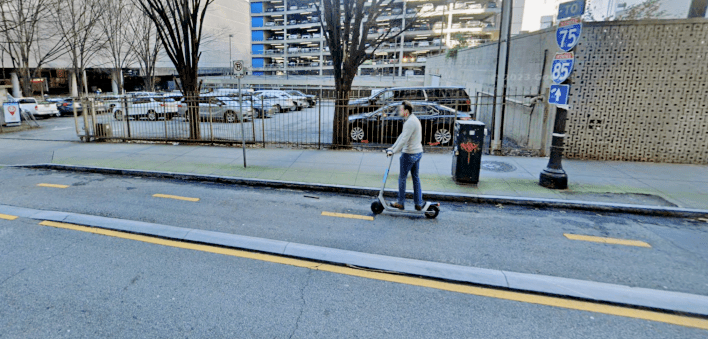Paint-only bike lanes may be associated with an increase in rates of crashes between drivers and cyclists, a new Atlanta study found — and even protected bike lanes that give way to paint at intersections may be endangering riders, too.
In a fascinating new analysis published in the Journal of Transport and Health, researchers at Emory University found that painted bike lanes and sharrows demonstrated "estimated harmful effects" — meaning drivers may actually be crashing into riders on such roads more than they would if there wasn't any paint on the ground.
Perhaps unsurprisingly, off-street trails and protected on-street lanes in the study demonstrated strong "estimated protective effects" compared to a hypothetical model, even on roads with only low curbs or plastic flex posts to separate road users.
To perform the analysis, researchers pored over 23 months of police reports and bicycle ridership data in the Big Peach to estimate per-mile crash rates along streets with a variety of different types of bike infrastructure, including the infamous sharrow marking, painted lanes that run alongside traffic, painted lanes with "buffer zones," as well as protected on-street bike paths and off-street trails.
Researchers then created an advanced model based on surrounding corridor data and other factors to estimate what each of those bike routes' crash rates would have been if they had no bike infrastructure at all — and compared those rates with the real-world data to get a sense of what kind of interventions are saving the most lives.

Photo: Google
The authors of the study were careful to note that their analysis carries some asterisks.
Because good bike data is so hard to come by in the U.S., the researchers had access only to limited data in a small region of just one city without many on-the-ground bike counters, plus whatever info they could source off the biking app Strava, which tends to attract strong and confident recreational riders more than everyday transportation cyclists.
But even after controlling for area-level household income and area-level population density — two factors which they hoped could serve as a decent proxy for whether cyclists were riding purely for fun or out of financial necessity — paint-only lanes and sharrows still seemed to be more dangerous than roads with nothing at all. And the researchers weren't totally sure why, especially considering that earlier studies in other communities have come to the opposite conclusion.
"It could be that the prototypical strong and confident cyclist is more likely to use the painted bike lane, and that drivers expect the cyclist to know what to do and get out of the way," said Michael Garber, a postdoctoral fellow at UC San Diego and the lead author of the study. "But I'm really not sure. At least anecdotally from riding in Atlanta, it does seem to me that it's more often unhoused people and other people who seem to be more disadvantaged who end up using bike lanes in high car traffic."

Garber suspects that Atlanta's paint-only lanes are so dangerous because they tend to be striped on roads that are more dangerous to everyone, contrary to professional guidance. The National Association of City Transportation Officials' gold standard design guide advises transportation officials to paint so-called "conventional" bike lanes only on relatively narrow roads with few cars and prevailing vehicle speeds under 25 miles; the researchers noted, though, that "several buffered and conventional bike lanes in the study area fail[ed] on all counts," including one particularly nasty arterial that reported five times more average annual daily traffic than the guide recommended for any road outfitted with a paint-only bike lane.
"As someone who rides a lot, I avoided conventional bike lanes in Atlanta for that reason," said Garber. "It just put me too close to a really dangerous conflict zone."

Even on Atlanta's best-protected bike paths, though, riders aren't necessarily safe — at least if they have to cross an intersection where their protection abruptly stops.
Garber explained that for the most part, the delineated lanes in the Atlanta sample gave way to standard crosswalks at multiple points, and that crossings didn't have safety features like corner islands to tighten a motorist's turning radius and make them more likely to see an oncoming rider. Without them, it was common to see drivers blocking the entrances and exits to bike lanes entirely, perhaps forcing riders to make dangerous maneuvers around them.
Add in the fact that protected bike lanes were still pretty rare in Atlanta at the time — there were around three miles of them in the whole city when the analysis was conducted — and the fact that local transportation officials favored potentially confusing (though probably not more injurious) two-way cycle tracks over one-way lanes that follow the same direction of travel as cars, and Garber suspects some drivers were legitimately surprised to see riders in their path, at least until they got used to seeing more of them around.


With at least $5.2 billion projected to be spent on bicycle and pedestrian projects in Atlanta by 2050, Georgia drivers can probably count on seeing a lot more bike paths in the future. The only question is whether they'll be designed in a safe, context-sensitive way — or whether they'll be little more than lines of paint on the ground next to blazing-fast drivers.
"I think there’s evidence that conventional bike lanes don’t do much to improve safety, and may actually harm safety in certain situations," he added. "Basically, this study bears out the idea that paint is not protection."






